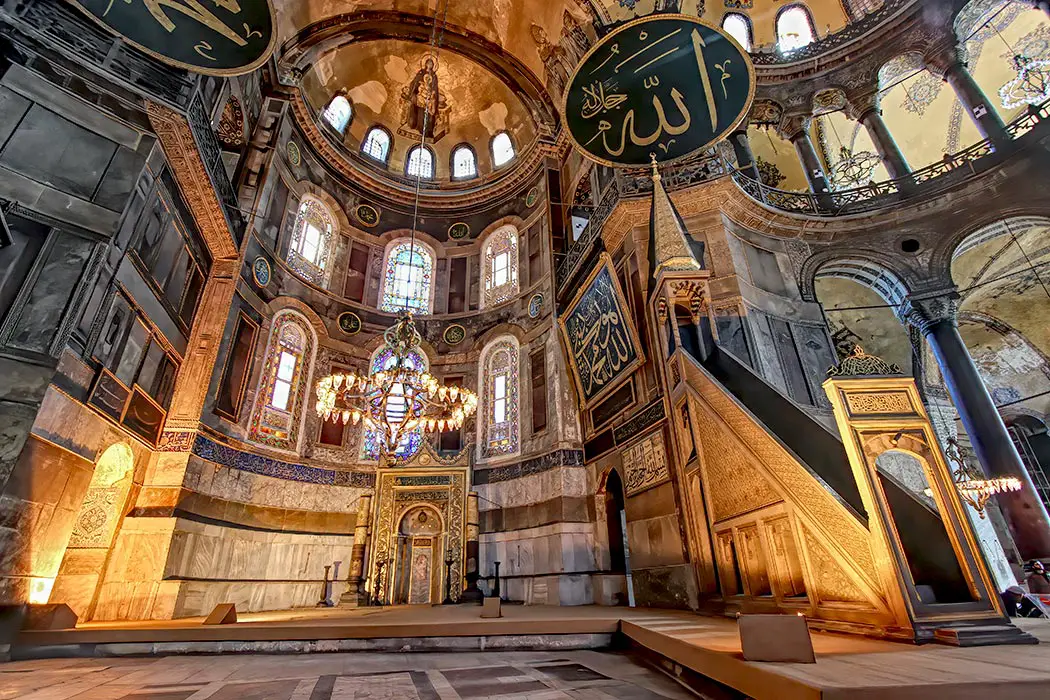Hagia Sophia: Enduring Megastructure Through The Ages

Table of Contents
From Byzantine Masterpiece to Ottoman Icon: The Hagia Sophia's Architectural Evolution
The Hagia Sophia's architectural journey is a testament to both its ingenious design and its adaptability across vastly different cultural contexts. Its enduring form reflects centuries of modifications and restorations, each era leaving its unique mark on the structure.
The Byzantine Era (532-1453): A Marvel of Engineering and Design
Construction of the Hagia Sophia, under the commission of Emperor Justinian I, began in 532 AD. This ambitious project, masterminded by the architects Anthemius of Tralles and Isidore of Miletus, showcased revolutionary Byzantine architecture.
- Innovative Architectural Techniques: The Hagia Sophia's design incorporated groundbreaking techniques, most notably the use of pendentives – curved triangular structures – to support the massive dome on a square base. This allowed for a vast, soaring interior space unlike anything seen before. The architects also skillfully employed materials such as brick, marble, and expertly cut stone, showcasing a mastery of construction.
- Immense Scale and Grandeur: The sheer size and grandeur of the Hagia Sophia were unprecedented. Its immense dome, measuring an astonishing diameter of 107 feet (32.6 meters), dominated the Constantinople skyline and served as a powerful symbol of the Byzantine Empire's might and imperial ambitions. Its impact on its contemporaries was profound, establishing new standards for scale and architectural innovation in Byzantine architecture.
- Use of Light and Space: The design incorporated innovative ways to maximize natural light, creating a luminous interior space that inspired awe in its visitors. Large windows and the immense dome allowed abundant light to flood the interior, creating a breathtaking spectacle.
The Ottoman Era (1453-1931): Transformation and Adaptation
Following the Ottoman conquest of Constantinople in 1453, the Hagia Sophia underwent a significant transformation. Converted into a mosque, several key additions marked its shift towards Ottoman architecture.
- Conversion into a Mosque: The addition of four minarets, slender towers from which the call to prayer (adhan) is broadcast, was a significant change. A mihrab, a niche indicating the direction of Mecca, was also added, highlighting the building's new function as a place of Muslim worship.
- Ottoman Preservation and Embellishment: Despite its conversion, the Ottoman Empire recognized the Hagia Sophia's architectural significance and invested in its preservation and upkeep. Extensive repairs and restoration projects were undertaken to maintain its structural integrity, while embellishments including calligraphy, tilework, and additional decorative elements were added, reflecting the aesthetic preferences of the Ottoman period.
- Significant Restorations and Modifications: Over the centuries, numerous restorations and modifications were undertaken to address damage caused by earthquakes and other factors. These projects, while sometimes altering the original appearance, ensured the longevity of this incredible building, demonstrating a commitment to preserving its cultural value.
The Modern Era (1931-Present): Museum and Ongoing Significance
In 1931, under the leadership of Mustafa Kemal Atatürk, the Hagia Sophia was officially declared a museum, removing it from religious use. This marked a significant shift in its status, transforming it into a secular space dedicated to the preservation of its historical and cultural legacy.
- Museum Transformation: The conversion into a museum involved the removal of many Ottoman-era additions, aiming to reveal and restore elements from its earlier Byzantine phase. This process, while contentious at times, reflected a desire to present the building's complex history more fully.
- Ongoing Conservation Efforts: Despite its status as a museum and UNESCO World Heritage Site, the Hagia Sophia still requires ongoing conservation efforts to maintain its structural integrity and safeguard its priceless mosaics and other artwork. These endeavors are crucial to preserving this architectural treasure for future generations.
- Recent Reclassification: The Hagia Sophia's status has once again shifted. Its 2020 reclassification as a mosque has reignited global discussion about its historical significance, religious implications, and cultural legacy.
Hagia Sophia's Enduring Influence on Architecture and Art
The Hagia Sophia's architectural innovation and artistic splendor have had a profound and enduring impact on the world of art and architecture. Its influence continues to be felt centuries later.
Architectural Inspiration Across Centuries
The Hagia Sophia's revolutionary dome design, supported by pendentives, has had a significant impact on subsequent architectural projects.
- Influence on Dome Design: The Hagia Sophia's dome has served as a model for countless dome-based structures across various styles and eras. The innovative design of the dome and pendentives profoundly impacted architectural practices, shaping how monumental structures were conceived and built.
- Specific Examples of Architectural Inspiration: The dome's influence can be observed in numerous buildings, both directly and indirectly. From Renaissance cathedrals to modern structures, architects have drawn inspiration from the Hagia Sophia's masterful blending of scale, space, and light.
Artistic and Cultural Significance
The Hagia Sophia's interior boasts a stunning collection of mosaics, representing a rich artistic heritage.
- Byzantine Mosaics and Art: The mosaics, surviving from the Byzantine era, depict religious figures and scenes, offering a glimpse into the rich cultural and religious life of that period. These works of art are crucial for understanding Byzantine artistic traditions.
- Religious and Cultural Symbolism: The art within the Hagia Sophia carries profound religious and cultural symbolism, reflecting the changing religious and political landscapes through which it has passed. Understanding this symbolism is key to interpreting the building's multifaceted history.
Hagia Sophia as a Symbol of Cultural Exchange and Religious Tolerance (or Intolerance, depending on perspective)
The Hagia Sophia's history is a complex narrative of shifting religious power dynamics, cultural exchange, and at times, religious intolerance. Its significance transcends architectural marvels and delves into the very heart of human history.
A Site of Shifting Religious Power Dynamics
The Hagia Sophia stands as a unique symbol of evolving religious significance.
- Changing Religious Significance: Originally a Christian cathedral, it later became a Muslim mosque and then a museum, reflecting the changing political and religious landscape of the region. Each shift marked a profound transition, underscoring the shifting religious and political power dynamics of the era.
- Diverse Religious Communities: The building's diverse history showcases the significant religious communities that utilized and impacted its design and significance. Understanding this multifaceted history illuminates the rich confluence of beliefs and cultures that have shaped its character.
Modern Debates and Interpretations
The Hagia Sophia’s reclassification as a mosque in 2020 has reignited fervent debate globally.
- The Hagia Sophia Controversy: The decision has prompted discussions about religious freedom, cultural identity, and political implications, underscoring the complex interplay of history, religion, and politics.
- Differing Perspectives: Various interpretations exist regarding the building's religious and cultural significance, highlighting the continuing debate over its role in contemporary society. Understanding these diverse viewpoints is critical to a nuanced understanding of the Hagia Sophia’s ongoing importance.
Conclusion: The Enduring Legacy of the Hagia Sophia Megastructure
The Hagia Sophia's journey, from its innovative Byzantine origins to its modern-day status, showcases its incredible adaptability and enduring legacy. Its architectural evolution reflects the ingenuity of its builders and the cultural influences that have shaped its character over centuries. Its enduring influence on art and architecture continues to inspire awe and admiration. Moreover, the Hagia Sophia's complex role in cultural and religious history serves as a powerful reminder of the shifting power dynamics and the enduring nature of faith and cultural exchange. Explore the incredible history and architecture of the Hagia Sophia – a truly enduring megastructure that continues to captivate the world. Plan your visit today!

Featured Posts
-
 Is Anthony Edwards Playing Tonight Timberwolves Vs Lakers Injury Report
Apr 29, 2025
Is Anthony Edwards Playing Tonight Timberwolves Vs Lakers Injury Report
Apr 29, 2025 -
 Remembering Tragedy Louisville Residents Under Shelter In Place
Apr 29, 2025
Remembering Tragedy Louisville Residents Under Shelter In Place
Apr 29, 2025 -
 Minnesota Faces Attorney General Pressure Over Transgender Athlete Ban
Apr 29, 2025
Minnesota Faces Attorney General Pressure Over Transgender Athlete Ban
Apr 29, 2025 -
 Cassidy Hutchinsons Memoir Key Jan 6 Witness Tells All This Fall
Apr 29, 2025
Cassidy Hutchinsons Memoir Key Jan 6 Witness Tells All This Fall
Apr 29, 2025 -
 Anthony Edwards Loses Paternity Case Ayesha Howard Granted Custody
Apr 29, 2025
Anthony Edwards Loses Paternity Case Ayesha Howard Granted Custody
Apr 29, 2025
Latest Posts
-
 Our Yorkshire Farm Amanda Owens Emotional Farewell
Apr 30, 2025
Our Yorkshire Farm Amanda Owens Emotional Farewell
Apr 30, 2025 -
 The Challenges Of Growing Up On Our Yorkshire Farm Reuben Owens Perspective
Apr 30, 2025
The Challenges Of Growing Up On Our Yorkshire Farm Reuben Owens Perspective
Apr 30, 2025 -
 Our Yorkshire Farm Reuben Owen Opens Up About His Childhood Struggles
Apr 30, 2025
Our Yorkshire Farm Reuben Owen Opens Up About His Childhood Struggles
Apr 30, 2025 -
 Our Yorkshire Farm Channel 4 Announcement Sparks Further Complaints Against Amanda Owen
Apr 30, 2025
Our Yorkshire Farm Channel 4 Announcement Sparks Further Complaints Against Amanda Owen
Apr 30, 2025 -
 Amanda Owen Raising 9 Children On Our Farm Next Door
Apr 30, 2025
Amanda Owen Raising 9 Children On Our Farm Next Door
Apr 30, 2025
